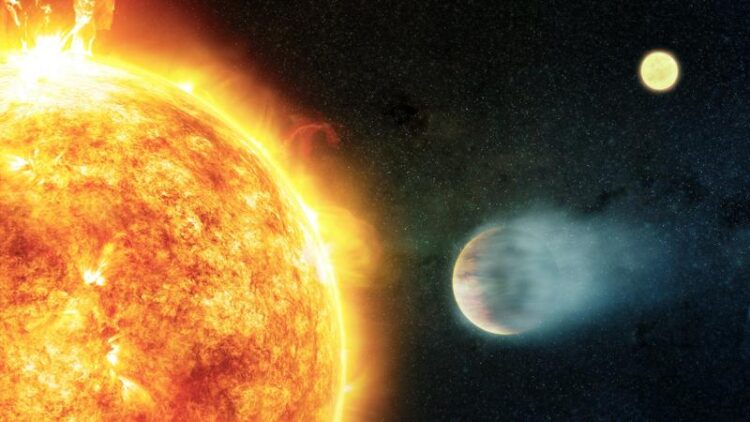Planets can be anti-aging formula for stars

Illustration of a hot Jupiter orbiting its host star. In the background, the second star of the binary system is visible.
(c) NASA/CXC/M. Weiss
Planets can force their host stars to act younger than their age, according to a new study of multiple systems authored by scientists from the Leibniz Institute for Astrophysics Potsdam (AIP) using NASA’s Chandra X-ray Observatory. This may be the best evidence to date that some planets apparently slow down the aging process for their host stars.
While the anti-aging property of hot Jupiters, that is, giant gas exoplanets that orbit a star at Mercury’s distance or closer, has been seen before, this result is the first time it has been systematically documented, providing the strongest test yet of this exotic phenomenon.
“In medicine, you need a lot of patients enrolled in a study to know if the effects are real or some sort of outlier,” said Nikoleta Ilic, a PhD student in AIP’s Stellar Physics and Exoplanets section, who led this new study. “The same can be true in astronomy, and this study gives us the confidence that these hot Jupiters are really making the stars they orbit act younger than they are.”
A hot Jupiter can potentially influence its host star by tidal forces, causing the star to spin more quickly than if it did not have such a planet. This more rapid rotation can make the host star more active and produce more X-rays, signs that are generally associated with stellar youth.
As with humans, however, there are many factors that can determine a star’s vitality. All stars will slow their rotation and activity and undergo fewer outbursts as they age. Because it is challenging to precisely determine the ages of most stars, it has been difficult for astronomers to identify whether a star is unusually active because it is being affected by a close-in planet, making it act younger than it really is, or because it is actually young.
The researchers approached this problem by looking at double-star, or, “binary” systems where the stars are widely separated but only one of them has a hot Jupiter orbiting it. Astronomers know that just like human twins, the stars in binary systems form at the same time. The separation between the stars is much too large for them to influence each other or for the hot Jupiter to affect the other star. This means they could use the planet-free star in the system as a control subject.
“It’s almost like using twins in a study where one twin lives in a completely different neighborhood that affects their health,” said co-author Professor Katja Poppenhäger, head of the Stellar Physics and Exoplanets section at AIP. “By comparing one star with a nearby planet to its twin without one, we can study the differences in behaviour of the same-aged stars.”
The team used the amount of X-rays to determine how “young” a star is acting. They looked for evidence of planet-to-star influence by studying almost three dozen systems in X-rays using Chandra and XMM Newton observations. They found that the stars with hot Jupiters tended to be brighter in X-rays and therefore more active than their companion stars without hot Jupiters.
“In previous cases there were some very intriguing hints, but now we finally have statistical evidence that some planets are indeed influencing their stars and keeping them acting young,” said co-author Marzieh Hosseini, also of AIP. “Hopefully, future studies will help to uncover more systems to better understand this effect.”
Wissenschaftliche Ansprechpartner:
Nikoleta Ilic, +49 331 7499 353, nilic@aip.de
Prof. Dr. Katja Poppenhäger, +49 331 7499 521, kpoppenhaeger@aip.de
Originalpublikation:
Tidal star–planet interaction and its observed impact on stellar activity in planet-hosting wide binary systems. N. Ilic, K. Poppenhaeger, S. Marzieh Hosseini, 2022, MNRAS, 513, 3, 4380
https://doi.org/10.1093/mnras/stac861
Weitere Informationen:
https://www.aip.de/en/news/planets-anti-aging-stars News on AIP website
https://chandra.si.edu/press/22_releases/press_110222.html NASA News
Media Contact
All latest news from the category: Physics and Astronomy
This area deals with the fundamental laws and building blocks of nature and how they interact, the properties and the behavior of matter, and research into space and time and their structures.
innovations-report provides in-depth reports and articles on subjects such as astrophysics, laser technologies, nuclear, quantum, particle and solid-state physics, nanotechnologies, planetary research and findings (Mars, Venus) and developments related to the Hubble Telescope.
Newest articles
Faster, more energy-efficient way to manufacture an industrially important chemical
Zirconium combined with silicon nitride enhances the conversion of propane — present in natural gas — needed to create in-demand plastic, polypropylene. Polypropylene is a common type of plastic found…

Energy planning in Ghana as a role model for the world
Improving the resilience of energy systems in the Global South. What criteria should we use to better plan for resilient energy systems? How do socio-economic, technical and climate change related…

Artificial blood vessels could improve heart bypass outcomes
Artificial blood vessels could improve heart bypass outcomes. 3D-printed blood vessels, which closely mimic the properties of human veins, could transform the treatment of cardiovascular diseases. Strong, flexible, gel-like tubes…





















